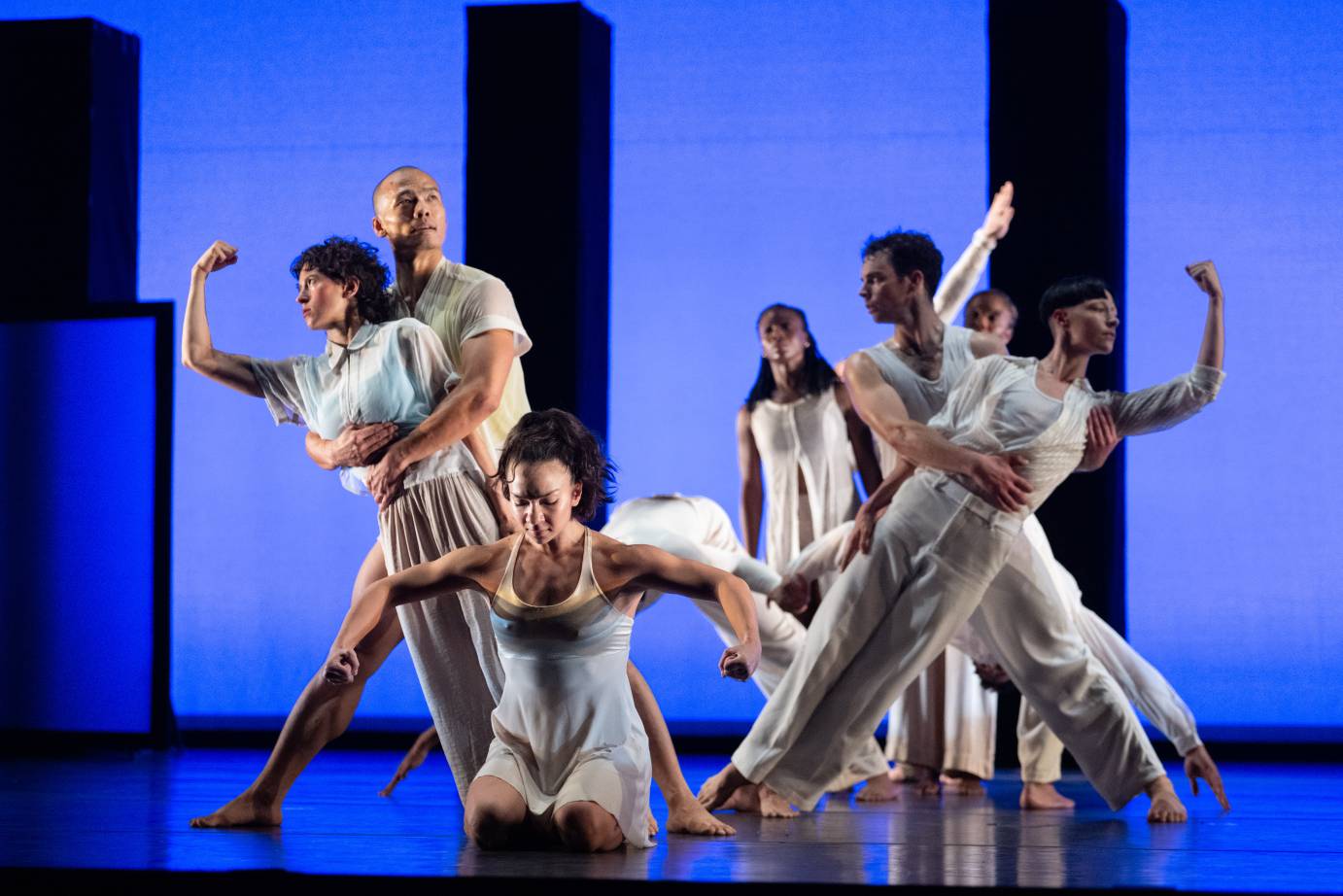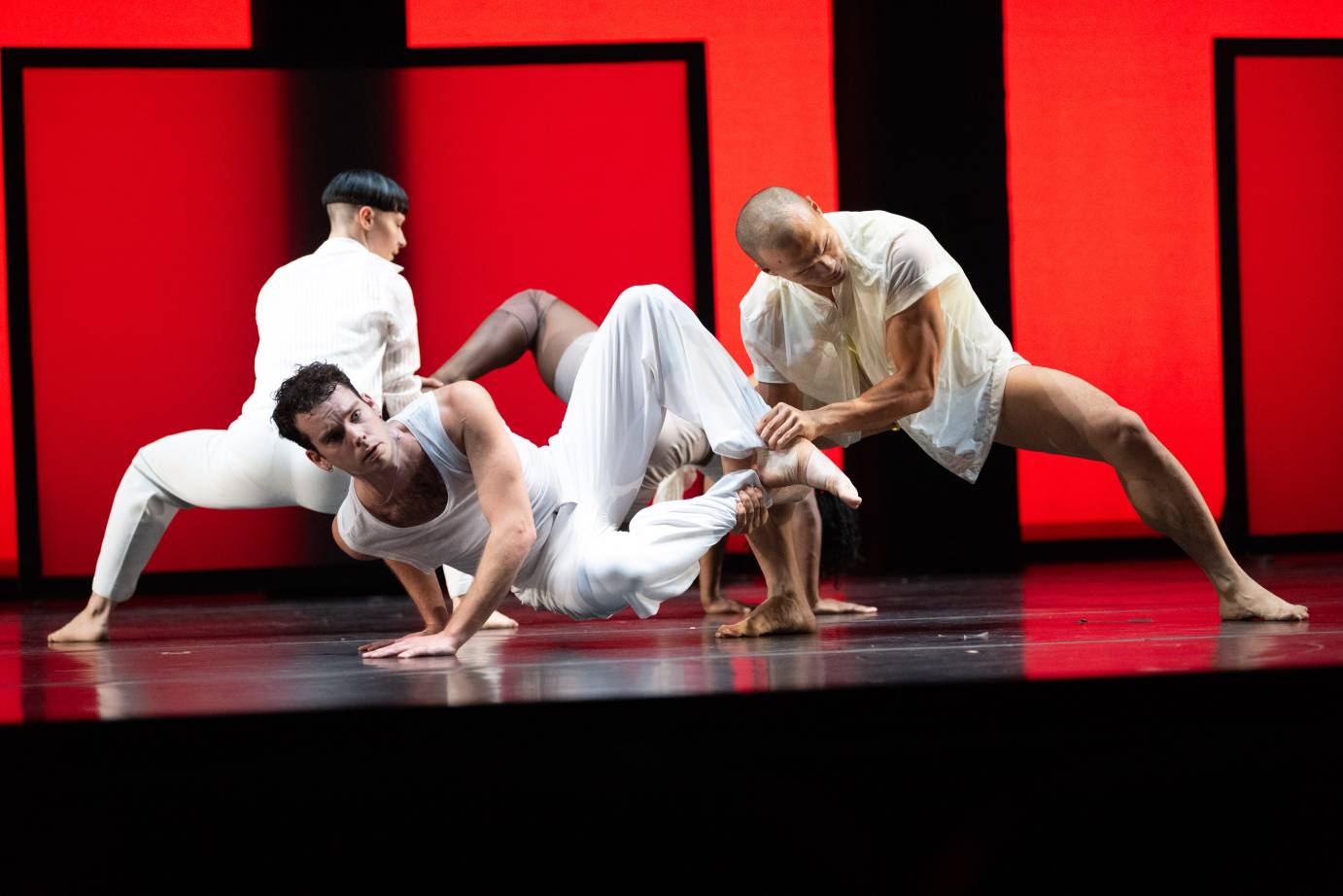IMPRESSIONS: Reflections on "Still/Here" 30 Years Later, Performed by Bill T. Jones/Arnie Zane Company at BAM

Conceived, choreographed, and directed by Bill T. Jones
Visual concept and media environment by Gretchen Bender
Lighting design by Robert Wierzel
Costume design by Liz Prince
Still music composed and lyrics arranged by Kenneth Frazelle
“Denial” monologue written by Lawrence Goldhuber
Here music composed and arranged by Vernon Reid
Produced by New York Live Arts with lead support from BAM (Brooklyn Academy of Music) and Dance Reflections by Van Cleef & Arpels.
Performances: October 30 - November 2, 2024
Viewed on: October 31 and November 1, 2024
This piece is written by Henning Rübsam with his Fordham/Ailey students: Jyn Orlowski, Kristin Grace Robinson, Sarah Hladky, Gianna McGrath, Sophia Cooper, Chianne Rice, Jonah Riley, Pia Brosmith, and Layla Barber
Given the history of Bill T. Jones’s Still/Here — probably the most discussed dance work of the last 30 years — reviewing it is a daunting task. One cannot get around mentioning Arlene Croce’s 1994 non-review “Discussing the Undiscussable,” in The New Yorker, in which she stated that she chose not to see what she termed “victim art.” She therefore wrote an opinion piece on her aesthetic preferences, and how the dance world had moved away from them. While she raised many points worth discussing, the fact that she based her article on a show she did not attend disqualified her, and, in turn, the work became a cultural milestone in US-American history.
Traumatized by the effects of the AIDS epidemic when I first saw the piece in 1994, I needed two additional viewings, thirty years later, to comprehend that the work is not limited to dealing with HIV, but that it addresses and inspires everyone facing terminal illness.

On Thursday, I got to see the work from my assigned orchestra seat at the Brooklyn Academy of Music (BAM), to review for this publication. Weeks beforehand, however, I had decided to take my dance history students in the BFA Ailey/Fordham program to witness the production that had rocked the boat when I was close to the age they are now. Therefore, on Friday night, I gained yet a new perspective watching the piece from a balcony seat alongside them. Discussions in class, the next time we convened, and the students’ written reviews convinced me of Still/Here’s continued relevance.
Excerpts from the students’ reviews follow:
Jyn Orlowski:
“The work, choreographed by Bill T. Jones, and restaged by Jones and Janet Wong, explores the experiences of people living with terminal illnesses, and how those experiences affect their mindsets, livelihoods, and relationships. The piece is set to soaring music by Kenneth Frazelle and Vernon Reid, among other musical and written works, which all add to the vibrant life of the piece.”
Kristin Grace Robinson:
“Jones, who had lost his partner, Arnie Zane, to AIDS in 1988, and is himself HIV-positive, explores what it means to “still” be alive and “here” following the death of a loved one.

Sarah Hladky:
“Still/Here is a choreographic work centered around the life experiences of those suffering through chronic/fatal illness, which seeks to explore not only how their diagnosis affects their daily lives, but also the impact it has on how the rest of the world views them and — more importantly — how they view themselves.”
Gianna McGrath:
“Through a series of “survival workshops” that Jones conducted across the country with those living with life-threatening illness, the participants became the foundation of the piece, as their gestures, words, and images formed the performance. This piece honors both the strength and vulnerability of the participants, and the revival showcases how Jones’s work transcends the moment/era in which it was created.”

Kristin Grace:
“The dancers wear minimalist neutral-toned clothing, yet subtle hints of color in several dancers’ undergarments allow for noticeable individuality within the cast. While the neutral tones symbolize humanity’s inevitable encounter with mortality, reminding us of stark clinical environments like hospitals and psych wards, they also signify fragility and vulnerability.”
Gianna:
“The athleticism throughout this dance is unmatched. The endurance and strength needed to pass fluidly from floor work, into lifts, and back to the floor all in one continuous moment beautifully portray an emotional and physical rollercoaster.”
Sophia Cooper:
“Perhaps even more impressive than the dancers’ level of dance technique was their ability to tell a story that is deeply rooted in both personal experience and public outcry. The dancers seamlessly transitioned from executing challenging dance sequences to speaking emotional monologues.”

Chianne Rice:
“When a dancer's voice breaks the quiet, the effect is electrifying, as it challenges the expectation that dance communicates only through movement. This unexpected vocal element deepens the emotional resonance, offering a more direct, human connection to the story being told.”
Sarah:
“Dancers begin to speak, introducing the names of different people and performing an associated gesture that embodies their spirit. For some this is a snap, a sassy quip, while others shake embodying the stress and anxiety in their lives. As the work continues, the audience never loses sight of these individuals because the work continually features these small gestures; an impactful way of keeping the human beings behind this work alive within it.”
Jonah Riley:
“The lighting design created by Robert Wierzel brought the entire project together. One captivating moment occurred when a single flashlight upon a male-presenting dancer creates an illusion that he’s towering over the entire opera house. His shadow acts as a metaphor. It suggests that even in your most powerful state you can be vulnerable.”

Sarah:
“The light also continually bounced from one dancer to another, never remaining on one person too long, inciting the feeling of being poked and prodded by an outsider. However, this light was not just directed towards the dancers, but also was often flashed towards the viewers as well. In these moments, the audience was transported —just like the people the dancers were embodying — into the hospital room, where harsh lighting induced the feeling of being overly on display. But, just as the light was exposing, it also provided a darkness for the other performers to pass though, running around the stage undetected until the beam flashed their way.
This is the flip side of chronic illness; those suffering often fight right in front of our eyes, and no one knows. While this anonymity can be liberating, as indicated through the brisk running and leaps taking place in darkness, it can also be incredibly frustrating for those whose pain is suggested by the harsh sounds of their footsteps in the dark.”

Jonah:
“The film projections created by Gretchen Bender added another level of complexity. These flickering images included unsettling pictures, childhood reminders, martial arts, and more. The dancers interacted with the projections embodying the visual. While the use of film was a great concept, many of the images shown on the screen toward the middle of the performance were disturbing.”
Pia Brosmith:
“Parts of those images were vulgar and graphic, but I feel as though they added a harsh realism to the piece.”
Kristin Grace:
“The first act heavily features gestural language, but in the second act, Here, Jones deepens the emotional and thematic exploration, focusing on resilience, community, and the complex interplay between fear and hope. I am enthralled by the dynamic and communal choreography, a drastic shift from the somewhat monotonous movement in the act prior.”

Gianna:
“Additionally, the non-traditional partnering feels very intentional and natural in the best way. Especially in the few moments in which a female dancer supports/suspends a male dancer, it truly exemplifies a type of oneness in which the audience views the dancers simply for who they are and who they represent, rather than in the traditional gender roles an audience may be used to seeing.”
Jyn:
“The second act shifts noticeably to more explicit concert dance. However, the choreography calls back some shapes and moments from act one, “dancifying” these motifs, and giving the choreography the same richness as in the first act.
One thing in particular that is absolutely commendable about this piece is the non-traditional gendering of the dance. This piece, more than any I’ve seen, perfectly expresses the modern idea of genderless dance and partnering, recognizing the unique experiences of different sexes, genders, and sexualities.”

Sarah:
“The second act opens with the dancers no longer in their white, hospitalized attire, but instead in striking shades of reds, pinks, and oranges. During a multitude of jumps, lifts, and runs, red light floods the stage as images of an anatomical heart are projected above on screens. The sounds of ventilation replace the music. While this change suggests a frightening return to the hospital imagery of the first act, here — in their bright colors — the dancers reclaim an image of life. They revisit the introductory gestures from the beginning, but they transfer them to each other, actively showing unity and support through the use of partner work, both in hands-on manipulation and weight-sharing lifts. While there are occasional moments when the dancers begin to falter and lie down on the floor, the community is there to support them both physically and emotionally, propping them up until they can return to the group. This movement inspires hope, and reminds audiences that support is there for those who are suffering.”
Layla Barber:
“A hopeful sense of community support suggests that no one is alone in battling health issues, but completely different sections follow immediately. This ‘bait and switch’ tactic reminds us of a harsh reality: nothing about humans coping with illness is linear.”

Kristin Grace:
“Vernon Reid’s score in the second act blends rhythmic, energetic passages with moments of poignant lyricism. Percussive beats may emerge, driving the action and evoking a heartbeat — a reminder of life’s persistence. Melodic lines, performed on strings or piano, provide a contrast, offering moments of introspection and beauty amidst the intensity.
The interplay of recorded voices with the live score continues, but the voices now speak of hope, strength, and the will to continue- emblematic of Jones’s emotionally authentic personal experience. Silence is less frequent, replaced by full and layered soundscapes that suggest a growing sense of unity and purpose. The drastic shift from introspection in the first act to communion in the second reflects the journey from isolation to connection, from fear to acceptance. It evokes a range of emotions: joy, defiance, and a bittersweet acknowledgment of life’s fragility. Bill T. Jones blends his distinct choreography with creative audio and visual elements to embody everything he felt in those years of diagnosis and loss, reminding us of the power of connection, and calling us to embrace life fully, even in the face of its inevitable end.”
Gianna:
“A talkback with the choreographer adds value to the performance. Jones’s explanations of how this performance replicates yet differs from the original highlight how the AIDS epidemic and its impact continue to be a relevant conversation. While the steps and details of the show remain the same as the original work in the ‘90s, the emotions and understanding of the work have adapted with the survivors.”













